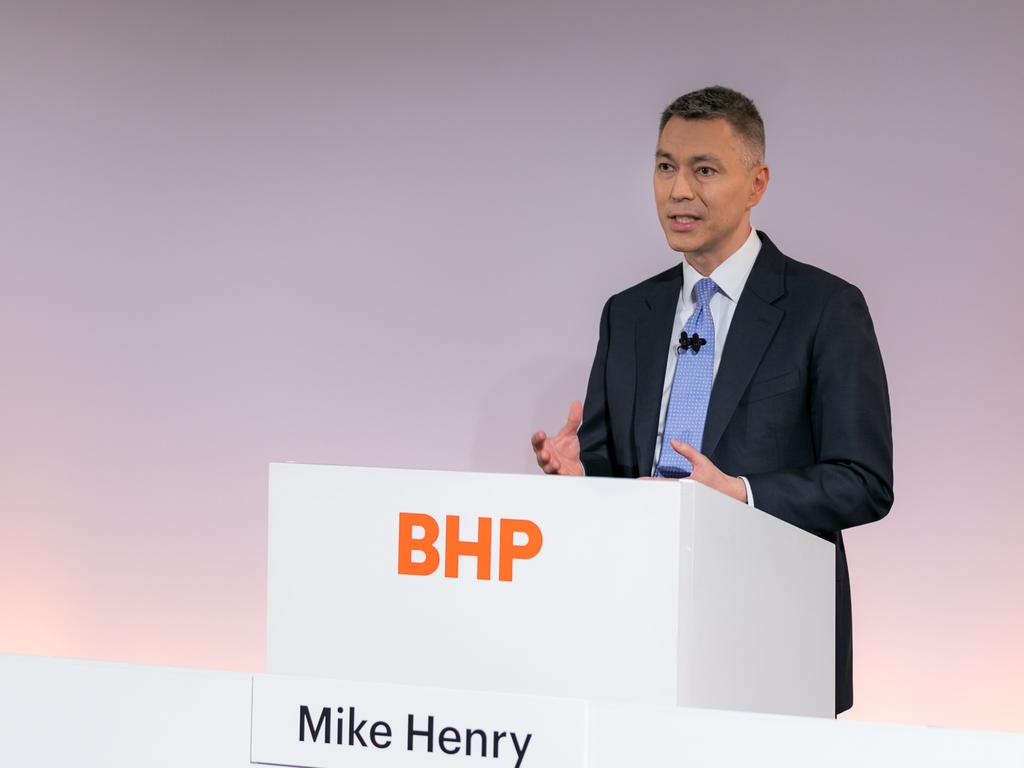BHP paying off debt early as iron ore boosts cashflow
BHP has been paying off debt as iron ore cash pours in, but Olympic Dam expansion plans have been called off yet again.

BHP says it has been paying off debt as the cash pours in from its iron ore operations, but the mining major has abandoned yet another expansion plan for its Olympic Dam mine in South Australia.
BHP released its quarterly production report on Tuesday, saying it had completed its repurchase of $US1.9bn of hybrid notes from “surplus cash” in mid-September, paying a premium of their par value, and last week called in another $US1bn worth of hybrid notes early.
With the iron ore price still tracking around $US120 a tonne for much of the September quarter, production at BHP’s Pilbara iron ore operations softened slightly compared to the June period, down 1 per cent to 74 million tonnes.
But its Pilbara mines still ran at an annualised rate of 296 million tonnes a year in the period, well ahead of the top end of its annual guidance of 286 million tonnes.
BHP said it expected December period production to be lower as it begins to link up its under-construction South Flank mine the rest of its network, and conducts major maintenance at its Port Hedland unloading infrastructure.
The company said it remained on track to ship between 276 and 286 million tonnes of iron ore from its Pilbara operations this financial year.
But while chief executive Mike Henry hailed a “strong first quarter” from a production perspective, BHP still had its hiccups in the period, with the company abandoning yet another expansion plan for its Olympic Dam copper and uranium operations in South Australia.
BHP ditched its original plans for a massive $US20bn open cut operation at the mine in 2012, and instead investigated the possibility of a giant heap leach operation. That, too, went by the wayside, to be replaced by the company’s so-called BFX plan – or brownfields expansion plan.
Originally tipped to cost about $US2.1bn and deliver an operation capable of producing 330,000 tonnes of copper a year, expectations for the expansion were scaled back in May 2019 when BHP flagged concerns about whether the geology of the Olympic Dam was suitable for its plans. The update added about $US400m to the expansion’s cost and downgraded likely output to 240,000 and 300,000 tonnes a year.
BHP has now abandoned the plan entirely and gone back to the drawing board, saying it does not believe BFX can deliver the required returns on investment.
“Following more than 400 km of underground drilling associated with the Brownfield Expansion (BFX) project studies, we have improved knowledge of the ore body’s variability. This has provided challenges for the economics of the BFX project, and we have decided the optimal way forward for now is through targeted debottlenecking investments, plant upgrades and modernisation of our infrastructure,” the company said.
“We will continue to study longer-term options for growth. Over the next two years, our focus will remain completing our asset integrity program. This will underpin more stable operations and expected copper production of more than 200,000 tonnes a year.”
That asset improvement program appears to be delivering results, however, with Olympic Dam recording its best set of quarterly operating figures in almost five years in the period, producing 52,000t of copper.
BHP also said problems building deep shafts to service its Jansen potash project have caused a $US272m blowout in the cost of the first stage of the project, to $US3bn.
Construction of an operating mine at the deep potash project has not been approved by the BHP board, with a final investment decision not expected until mid-2021.
“BHP has started the new financial year with a strong first quarter of safety and production performance. Group production rose two per cent from a year ago driven by solid results in metallurgical coal and iron ore, our major growth projects made good progress, and we secured more options in copper, nickel and oil,” Mr Henry said.
“While our copper operations in South America continue to be impacted by COVID-19 preventative measures, we achieved strong concentrator throughput at Escondida and expect first production from the Spence Growth Option before the end of March 2021. In Australia, Olympic Dam delivered its best quarterly production in the past five years and we are on track for first production from South Flank in the middle of the 2021 calendar year.”
BHP’s copper production was in line with the June period, at 413,000 tonnes, and down 4 per cent compared to the same period in 2019 on the back of coronavirus restrictions in its South American operations.
Production at Escondida fell 3 per cent to 285,000t, with BHP saying the issues caused by the pandemic sweeping through its workforce could linger for some years to come.
“The operating environment remains challenging, with a high degree of uncertainty about the continued impacts from COVID-19 and expected absenteeism levels,” BHP said.
“Production is also likely to be affected in the 2022 financial year as a result of the COVID-19 impact of reduced operational workforce leading to lower material movement in the 2021 financial year.”
BHP shares closed Monday at $36.50.






To join the conversation, please log in. Don't have an account? Register
Join the conversation, you are commenting as Logout